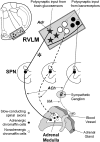Adrenaline: insights into its metabolic roles in hypoglycaemia and diabetes
- PMID: 26896587
- PMCID: PMC4831313
- DOI: 10.1111/bph.13458
Adrenaline: insights into its metabolic roles in hypoglycaemia and diabetes
Abstract
Adrenaline is a hormone that has profound actions on the cardiovascular system and is also a mediator of the fight-or-flight response. Adrenaline is now increasingly recognized as an important metabolic hormone that helps mobilize energy stores in the form of glucose and free fatty acids in preparation for physical activity or for recovery from hypoglycaemia. Recovery from hypoglycaemia is termed counter-regulation and involves the suppression of endogenous insulin secretion, activation of glucagon secretion from pancreatic α-cells and activation of adrenaline secretion. Secretion of adrenaline is controlled by presympathetic neurons in the rostroventrolateral medulla, which are, in turn, under the control of central and/or peripheral glucose-sensing neurons. Adrenaline is particularly important for counter-regulation in individuals with type 1 (insulin-dependent) diabetes because these patients do not produce endogenous insulin and also lose their ability to secrete glucagon soon after diagnosis. Type 1 diabetic patients are therefore critically dependent on adrenaline for restoration of normoglycaemia and attenuation or loss of this response in the hypoglycaemia unawareness condition can have serious, sometimes fatal, consequences. Understanding the neural control of hypoglycaemia-induced adrenaline secretion is likely to identify new therapeutic targets for treating this potentially life-threatening condition.
© 2016 The British Pharmacological Society.
Figures




References
-
- Abel JJ (1898). On epinephrin, the active constituent of the suprarenal capsule and its compounds. Proc Am Physiol Soc 3‐4: iii–iiv.
-
- Addison T (1855). On the constitutional and local effects of disease of the suprarenal capsules. 1st edn Samuel Highley: London.
-
- Ahlquist RP (1948). A study of the adrenotropic receptors. Am J Physiol 153: 586–600. - PubMed
-
- Ahren B, Taborsky GJ Jr, Havel PJ (2002). Differential impairment of glucagon responses to hypoglycemia, neuroglycopenia, arginine, and carbachol in alloxan‐diabetic mice. Metabolism 51: 12–19. - PubMed
Publication types
MeSH terms
Substances
LinkOut - more resources
Full Text Sources
Other Literature Sources
Medical

